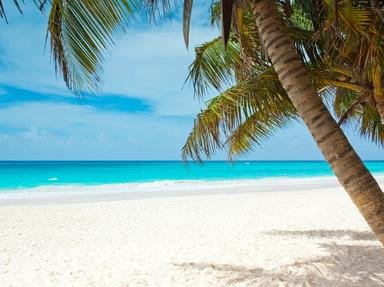Quiz Answer Key and Fun Facts
1. A visit to this rugged area in the interior of Jamaica is formidable and should not be undertaken lightly. The greater portion of the region lies in one of Cornwall's parishes and can be identified by its typical karst landscape. The region is well known for its biodiversity and is the refuge of several species that have been driven by human settlement from their homes in the rest of the island. What is the official name of this area?
2. Caves are a feature of the limestone regions of Trelawny, one of the Cornwall parishes. In fact, these caves are of great geographical interest and more than 75 of them have been explored. The largest and most accessible cave can be easily navigated for about 1 mile (1.6 km). What is the name of this largest cave?
3. The parish of St. Elizabeth has three mountain ranges. One of these mountain ranges ends abruptly on the south coast at a steep cliff that plunges to the Caribbean Sea at Cutlass Bay. This cliff is a well-known attraction called Lover's Leap. Name the mountain range that ends at Lover's Leap.
4. Sir William Alexander Bustamante, one of Jamaica's most colourful and revered politicians, was born in the County of Cornwall. He became Jamaica's first prime minister at the time of Independence in 1962. Where was Sir Alex born?
5. A former Spanish settlement, this south coast town in Cornwall became a parish capital in 1730. The town has been completely destroyed on numerous occasions by hurricanes, tidal waves and floods. Following each disaster, the remarkable citizens of this town rebuilt it and today it is a bustling commercial centre. Name this town and the parish of which it is the capital.
6. This Georgian-style Great House in St. James was formerly owned by the family of Elizabeth Barrett-Browning, the famous English poet. It is located on Jamaica's north coast in one of the western parishes. The building is more than 200 years old. What is the name of this Great House?
7. With the passage of the law abolishing slavery in 1834, plantations realized they would soon face a labour shortage. In an effort to solve the problem, European workers were brought to the island with the promise of housing, land titles and wages. The first indentured servants under this plan arrived from Germany in 1835 and some settled at Seaford Town in this Cornwall parish. What is the parish?
8. Tryall Club is located on the main road between the districts of Hopewell and Sandy Bay. It is an exclusive, private resort that was developed on the property of a former 17th century sugar and coconut plantation. The resort offers its members and guests stays in luxurious villas. What is the parish in which the resort is located?
9. Navigable for most of its 44 mile (73 km) length, this river's name refers to the darkness of its river bed. The river begins as an underground stream in the mountains of Manchester before emerging above ground at Siloah on the southern border of the Cockpit Country. Name this river.
10. In the 1960s, before the days of mandatory environmental impact studies, these 14 small islands lying off the north coast of the city of Montego Bay were transformed by dredging and landfilling to form the Montego Bay Freeport Scheme. The project created resorts, residential and industrial sites as well as a multi-berth deep water pier. What was the name of these islands?
Source: Author
mynah5459song
This quiz was reviewed by FunTrivia editor
Tizzabelle before going online.
Any errors found in FunTrivia content are routinely corrected through our feedback system.
